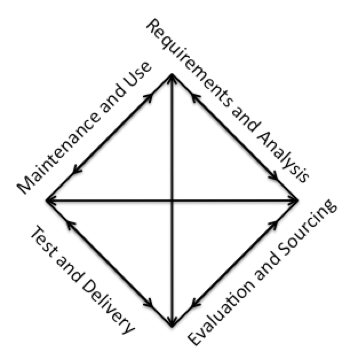While the idea of the SDLC (Systems Development Lifecycle) is firmly embedded in the Information System field, there is no single concrete principled formulation of the SDLC ‘sui generis.’ It is notable that the earliest formulations of systems development (Table 1: (Gregory and Richard L., 1963)) resonate strongly with current presentations (Valacich et al., 2009). Gregory and Richard (1963) described the four phases or stages involved in creating a new information system (Table below).
 |
| From Scrapbook Photos |
All formulations of the SDLC are derivative of other lifecycles described and used in practice prior to the various distillations of the SDLC. In spite of claims to the contrary there is no single authoritative well-understood methodology for managing the development of information systems. Each methodology is either the product of a particular group of people working in their specific work contexts, or the output of an academic or practitioner attempt to construct a generalizable description of development processes. The systems development life-cycle is a stage-wise representation of activities commencing with the most general description of some product to be designed and refined over stages into a completed good (Figure below).
 |
| From Scrapbook Photos |
The following table (Table below) summarises the conceptual stages of the SDLC. It is readily apparent that the systems development life cycle is synonymous with the waterfall model and that the waterfall provides us with many of the original concepts that comprise most if not all of the features of frameworks used to control and manage the production of high tech goods.
Table: Stages of the SDLC (adapted from Avison and Fitzgerald, 1995)
 |
| From Scrapbook Photos |
DISCUSSION: THE PRACTICAL REALITIES OF DEVELOPMENT
The SDLC is the original prototype of the life cycle. Linear, serial, stage-gate or milestone development life cycles are employed in product disciplines and in strategic models of competitive innovation (Schilling, 2005, Tidd et al., 2001, Trott, 2005). Life cycles applied in other industries and occupations overlap with the work of high-tech design and development and influence in turn how systems development is seen to be structured. Like the SDLC the product marketing life cycle covers: initial concept, to development, to market maturity and end-of-life. However while life cycle archetypes represent the relationships between analysis, design, implementation and maintenance, they do rarely describe their practical performance and accomplishment.
The work of developing, configuring, and servicing systems occurs within activities and processes such as service provision, project execution, product development and maintenance. These activities are located in time and place and so the day-to-day, week-to-week flux of production takes on the appearance of regularity, of a common pattern to process of creating and managing high tech objects. Systems development can be shaped with the aide of a life cycle model. Life cycle is simply a way of describing the relationships between work processes constituting the provision, development and delivery of a product or service. Having however taken a critical perspective on the SDLC and life cycle concepts generally I wish to explore and explain the value and need for their activities, albeit activities that often overlap, are 'out of sequence' and occur in haphazard and emergent fashion. The following sections analyse the generic characteristics of the core activities of systems development; summarised here as Requirements, Evaluation, Implementation, and Maintenance (below).

Figure: The SDLC as a tetrad of inter-related activity.
REFERENCES